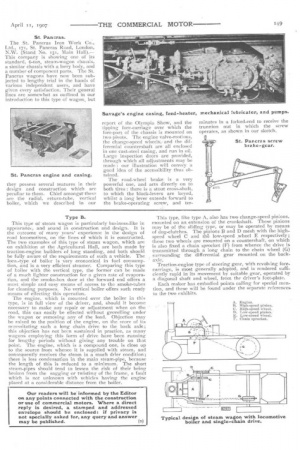Type B.
Page 19

If you've noticed an error in this article please click here to report it so we can fix it.
This type of steam wagon is particularly business-like in appearance, and sound in construction and design. It is the outcome of many years' experience in the design of road locomotives, on the lines of which it is constructed. The two examples of this type of steam wagon, which are on exhibition at the Agricultural Hall, are both made by traction-engine builders of long standing, and both should be fully aware of the requirements of such a vehicle. The loco.-type of boiler is very economical in fuel consumption, and is a very efficient steamer. Comparing this type of boiler with the vertical type, the former can be made of a much lighter construction for a given rate of evaporation, and the smoke-box door at the forward end offers a most simple and easy means of access to the smoke-tubes for cleaning purposes. No vertical boiler offers such ready means of effecting this operation. The engine, which is mounted over the boiler in this type, is in full view of the driver, and, should it become necessary to make any repair or adjustment when on the road, this can easily be effected without grovelling under the wagon or removing any of the load. Objection may be raised to the position of the engine, on the score of its necessitating such a long chain drive to the back axle; this objection has not been sustained in practice, as many wagons employing this form of drive have been running for lengthy periods without giving any trouble on that point. The engine, which is a compound one, is close up to the source from whence it is supplied with steam, and consequently receives the steam in a much drier condition; there is less condensation in the main steam-pipe, because the length of this is reduced to a minimum. The short steam-pipes should tend to lessen the risk of their be.ing, broken from the sagging or twisting of the frame, a fault which is not unknown with vehicles having the engine placed at a considerable distance from the boiler. This type, like type A, also has two change-speed pinions, mounted on an extension of the crankshaft. These pinions may be of the sliding type, or may be operated by means of dog-clutches. The pinions B and D mesh with the highspeed wheel C and the low-speed :wheel E respectively; these two wheels are mounted on a countershaft, on which is also fixed a chain sprocket (F) from whence the drive is transmitted through a long chain to the chain wheel (G) surrounding the differential gear mounted on the backaxle.
Traction-engine type of steering gear, with revolving forecarriage, is most generally adopted, and is rendered sufficiently rapid in its movement by suitable gear, operated by a diagonal shaft and wheel, from the driver's foot-plate.
Each maker has embodied points calling for special mention, and these will be found under the separate references to the two exhibits.






























































